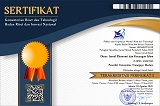Digital Currency Studies In Islamic Perspective
Abstract
This study aims to determine the best type of Digital currency according to Islam. This study uses the Analytical Hierarchical Process (AHP) method by developing several alternative digital currencies and attributes (indicators). In addition, this study also uses deductive qualitative analysis. Respondents in this study amounted to 100 people with the sampling technique Area Stratified Purposive Sampling and several selected respondents were interviewed. The results show that Gold-based Digital Money is the best type of Digital currency according to Islam. The main attribute of ownership in Gold-based Digital Money is Usury abolishment capability. Other factors are Gharar Eraducation, Maysir Eraducation, Justice / Fairness Principles, Medium of exchange, Measurement of value, Store of value and Differed payment instrument. In addition, this model can accommodate 7 criteria for the role of currency in the economy.
Keywords
Full Text:
PDFReferences
Abdullah, A. (2013). The Gibson paradox: Real gold, interest rates and prices.International Business Research,6(4), 32.https://doi.org/10.5539/ibr.v6n4p32
Abdullah, A. (2016).The Islamic currency. Kuala Lumpur: International Council of Islamic Finance Educators.
Dodik, S. et.al, 2020, The requirements of cryptocurrency for money, an Islamic view, journal homepage: www.cell.com/heliyon, 2020.
Ibrahim Bassam A. et.al, 2007, Developing a Digital currencyfrom an Islamic Perspective: Case of Blockchain Technology: IIUM Institute of Islamic Banking and Finance, Malaysia. Received:August 24, 2017Accepted:September 7, 2017Online Published: September29, 2017, doi:10.5539/ibr.v10n11p79URL: https://doi.org/10.5539/ibr.v10n11p79
Meera, (2018) Cryptocurrencies From Islamic Perspectives: The Case Of Bitcoin, Bulletin of Monetary Economics and Banking, Volume 20, Number 4, April 2018.
Pezzullo L, Filippo RD (2009) Perceptions of industrial risk and emergency management procedures in Hazmat Logistics: A qualitative mental model approach. Safety Science 47: 537-541.
Stock RJ, Lambert DM (2013) Strategic logistics management. International Journal of Physical Distribution & Logistics Management.
Saaty TL (2004) Decision making - the Analytic Hierarchy and Network Processes (AHP/ANP). Journal of Systems Science and Systems Engineering 13: 1-35.
Tung SL, Tang SL (1998) A comparison of the Saaty’s AHP and modified AHP for right and left eigenvector inconsistency. European Journal of Operational Research 106: 123-128.
Uma Devi K, Elango C, Rajesh R (2012) Vendor selection using AHP. In Procedia Engineering 38: 1946-1949.
DOI: https://doi.org/10.21107/dinar.v8i2.9954
Refbacks
- There are currently no refbacks.
Copyright (c) 2021 bedjo santoso, MA Irfan Rahmana, Atin Anggraini Surono

This work is licensed under a Creative Commons Attribution-ShareAlike 4.0 International License.
Journal Dinar Indexed by:
Dinar: Jurnal Ekonomi dan Keuangan Islam by Universitas Trunojoyo Madura is licensed under a Creative Commons Attribution-ShareAlike 4.0 International License.






.png)










